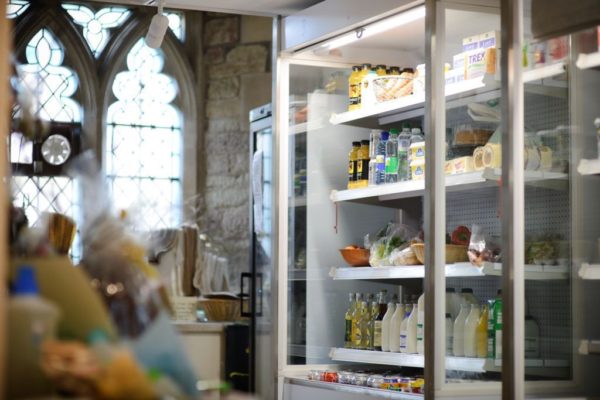
Inside St Leonard’s, a parish church in rural Herefordshire, can be found a bustling community-run shop, Post Office and café where residents from the village and surrounding area can do most of their shopping and catch up with neighbours and friends.
About Yarpole Community Shop in a church
Yarpole Community Shop and Café is one of the first community businesses to have opened in a rural place of worship and in 2019 it celebrated a decade of successfully trading for the benefit of local residents. It is a truly exceptional example of how a place of worship and the wider community can grow in strength when doors are opened and local people invited to have their say, own and run an enterprise that’s focused on meeting local needs.
Journey
Like many rural communities, Yarpole in Herefordshire lost its shop and Post Office – but the community felt both services were essential to village life. In 2005 the desire for these services to return was outlined in in its parish plan.
The decision was made to open a community business to meet this need. One of the biggest challenges the community faced was where they could locate their desired shop and Post Office. Initially the answer came in the form of shipping container in the local pub car park, funded in part by the sale of 306 shares to local residents at £10 each. Whilst the new community-run shop was popular, the shipping container was only ever a temporary solution due to a planning stipulation. A more permanent home was needed. It was eventually concluded that by far the best solution for Yarpole was to utilise the space within St Leonard’s – an idea inspired by Yarpole’s parish plan which had pointed out that the local church, the grade II* listed St Leonard’s, was underused.
The move to the church required a huge community effort and close collaboration with the Diocese of Hereford to work out how best to utilise space within the church in order to secure a permanent home. Extensive reordering was needed in order to accommodate the community shop, post office and café, whilst preserving the areas used for worship.
This is a project where there has been a lot of thought around the sharing of sacred and community space. Initial thoughts that a division should be created between the secular space and the sacred place have evolved into thinking about how the ‘sacred space’ can be integrated into a cohesive whole with the nave.
A design was finally reached which enabled both to coexist harmoniously. Worship would continue as well offering a flexible community space and numerous community activities in the west end of the church. The Victorian side aisle houses the toilets and vestry.
Raising the £240K required for the works and obtaining the necessary permissions proved the two most challenging aspects. As of 2018 there were 371 shareholders.
In 2009 the community opened its shop in the church, later adding a café. Yarpole Village Shop became the first full time community shop to operate within a church. It is open 7 days a week. The shop at the church work together in seemingly perfect harmony, with neither intruding on the activities of the other.
Social Impact
As well as the community shop and café at the church, Yarpole also has a community owned pub. Volunteering is said to be at the centre of village life, and the shop at the church was key to this community ethos. The shop itself runs on volunteers and offer opportunities to students involved with the Duke of Edinburgh scheme and regularly welcomes pupils from local special needs schools who also volunteer. The expanding community activities have helped tackle isolation within the community and brought increased connectivity through its broadband connection. The community businesses has gone on to win awards including the Countryside Alliance Village Shop and Post Office Award Best Village Shop in the UK, the Queen’s Award for Voluntary Service, and two Plunkett Awards. Its notoriety has also boosted visitor numbers to the village.
The presence of the community businesses in the church has also improved facilities, with the addition of toilets, lighting and better heating enabling the space to be used for more events such as concerts.





